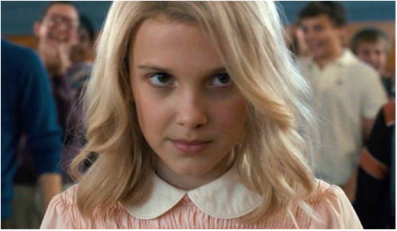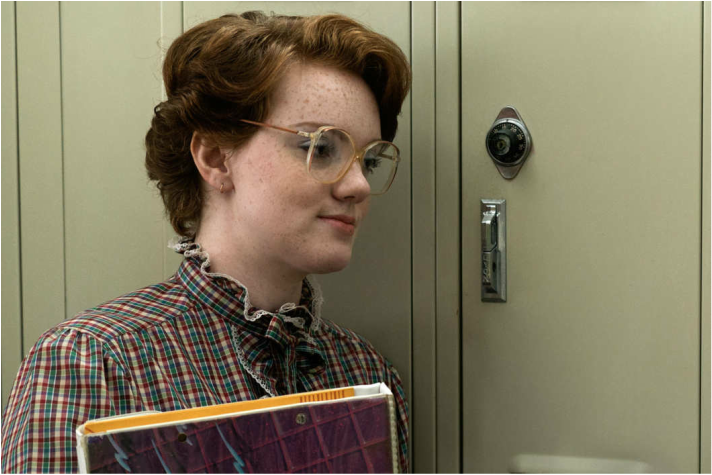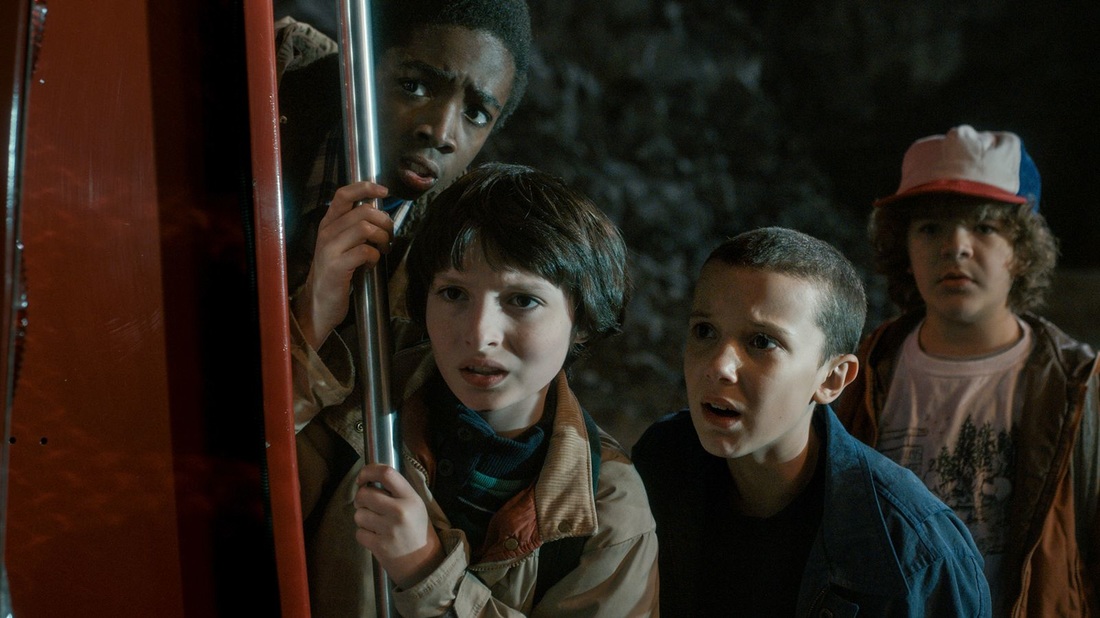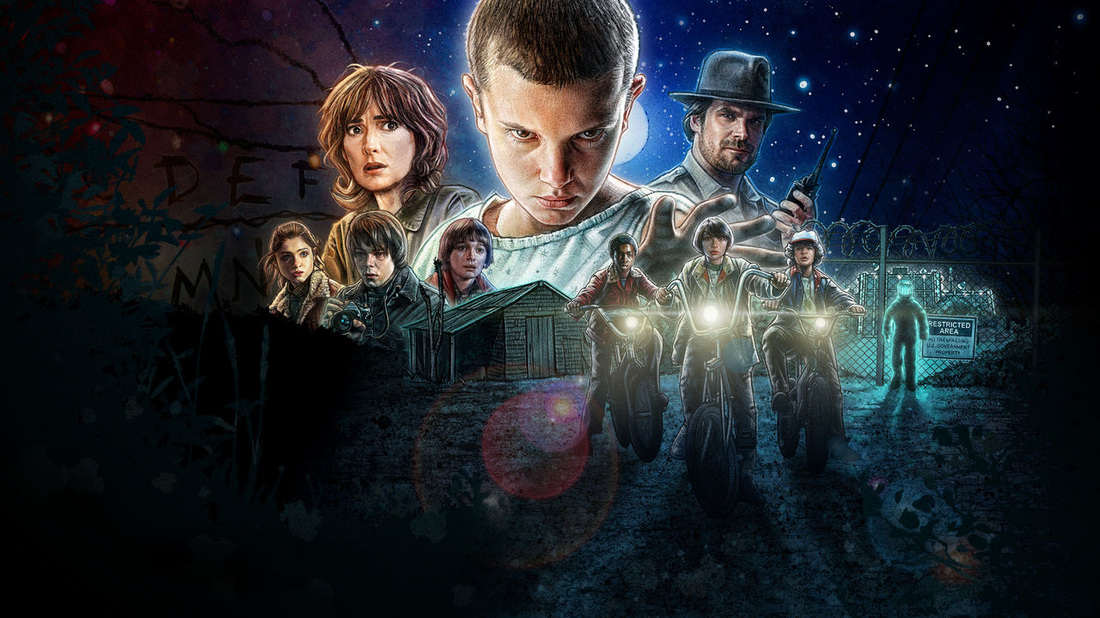Netflix original series Stranger Things has captured the hearts and imaginations of the Netflix generation. A deeply nostalgic breath of fresh air amidst re-runs, reality television shows, endless talent contests and period dramas, the brainchild of Matt and Ross Duffer bears all the hallmarks of a future cult classic.
Stranger Things is set in small-town America during the ’80s and for those who spent time immersed in ’80s and early ’90s horror, sci-fi and coming of age stories, the echoes of the past will clearly resonate. The group of nearly-teenaged misfits could be the boys of Stand By Me, the Losers Club of Stephen King’s It or the comic book-obsessed vampire hunters of Lost Boys. The school is populated by a teen-genre cast of clichés that wouldn’t look out of place in Pump up the Volume or Heathers. The Duffer brothers have further ramped up the nostalgia factor by casting Winona Ryder in a lead role. Ryder is an inspired choice and her very presence evokes fond memories of late ’80s and early ’90s cinema - the “strange and unusual” goth Lydia Deetz of Burton’s Beetlejuice, the beautifully weird romance of Edward Scissorhands and the mawkish blood-lust of Bram Stoker’s Dracula.
Despite the fact Stranger Things is a loving homage to all things ’80s, it remains fresh and the Duffer brothers are clearly well-versed on the rules for keeping an audience engaged. Stranger Things stands up against its bland peers and offers something different. The series has a darkness and an edge to it and if you’re the kind of person that can’t just enjoy television without scratching beneath the surface, it’s rich with subtext and social commentary. As well as being a fun, gripping, binge-worthy romp through the past, Stranger Things is also a modern day triumph and an unapologetic queer piece of television.
There may not be any openly LGBTQ identified characters in Stranger Things (as at the end of Season 1) but the narrative is no less queer because of it. From the outset the viewer is shown a landscape where the normative is idealised and the non-normative ostracised. The pretty, popular girl gets the guy while her less desirable best friend is literally left out in the cold. The political heavyweight is the white, middle-aged man who wields enough power to cover up a freaking hole in space and time (let’s hear it for the goddamn patriarchy). Ryder’s Joyce Byers spirals out of control while the people around her give her pitying looks and whisper about all the crazy behind her back. In fact, no one takes Joyce particularly seriously – she spends a fair bit of time talking to an actual brick wall. Thankfully, because this is Stranger Things when Joyce talks to the brick wall, it talks back. When the white-haired men try to do fancy things with gadgets they are bested by a girl. A very small pre-teen badass, no less. Stranger Things might be set in a time and a place where the normative is idealised, but the people the viewer is urged to root for are the freaks and the geeks – the people who are a little strange and a lot fabulous.
From the outset the viewer is introduced to a group of pre-teen boys playing Dungeons & Dragons, queer-coded Barb and introverted loner Jonathan. The school bullies are out in force from the outset and the ugly presence of homophobia rears its head even before a single grr-argh from the monster of the Upside Down, with frequent nods to the presumed homosexuality of the missing Will Byers. Monsters in Stranger Things don’t just exist in the Upside Down. They walk through the school hallway and accost people with flick-knives. They are the absent fathers, the corrupt social workers and government officials. The existence of the Upside Down simply serves as a reminder that monsters are everywhere.

It’s through the character of Eleven that Stranger Things really subverts traditional constructs of masculinity and femininity. Where Will (we are told) bears certain hallmarks of femininity, Eleven presents as a tomboy from the outset. Initially mistaken for a young boy with closely cropped hair, she is initially seen dressed in gender neutral hospital robes and, later, in Mike’s clothes. When Lucas suggests that Eleven looks like a “weirdo” and insists she look more “normal” the boys dress her in a blonde wig and oversized pastel pink dress, the very epitome of femininity. She looks in the mirror and describes herself as “pretty” but in reality the wig always looks uncomfortable and is constantly adjusted. It's a hindrance rather than a help. The dress remains until the end but is soon covered in dust and dirt and paired with trainers and a flannel jacket which all serve to detract from its initial 'girlishness'. A critical moment comes later when Eleven’s wig comes off and she finds herself in front of the same mirror in Mike’s house: “Still pretty?”; “Yeah, still pretty. Really pretty.”

Stranger Things is riddled with interesting queer subtext which will hopefully be further explored in the second series, but that doesn’t mean things are perfect. Jonathan rescues Nancy from the Upside Down and the way Steve Harrington swoops in towards the end and shows Nancy how to handle a bit of wood is an annoying (albeit probably necessary) part of his redemption arc. Joyce lacks any meaningful agency until Hopper sees the Upside Down for himself. There are aspects of the way the women are written that I hope will be refined in the second season. However, it’s the revelation of Barb’s death that really jarred for me.
Barb’s sexuality is never verbalised but she is a queer-coded character. The nature of her relationship with Nancy is expressly called into question by the police (“…it’s not like that”). Barb finds herself sent home by her best friend who leaves her in pursuit of a night of passion with her popular high-school boyfriend. She’s then left to contemplate her own reflection in a swimming pool, get swallowed up by the monster from the Upside Down and forgotten about for most of the remainder of the season. Her disappearance doesn’t exactly cause a state of panic. Barb’s mother expresses mild concern, Nancy (at least initially) and Steve seem more concerned about getting in trouble than Barb’s whereabouts and Steve’s friends joke about not knowing who Barb is or even realising she was at Steve’s house, such is her insignificance. When Barb’s death is revealed the reaction to that too is muted. For those of us who are tired of seeing the Dead Lesbian trope played out repeatedly in popular narratives, the death of a queer coded woman like Barb is an unwelcome one. In an interview with IGN, Matt Duffer seems aware of the internet cry for #JusticeForBarb and suggests that the repercussions of the events of the first season will be dealt with in a more satisfactory way in the second season.
The Duffer brothers indicated that they killed off Barb because they wanted the world of Stranger Things to feel unsafe. From a story-telling perspective this approach makes sense. If everybody survives, the narrative lacks the tension viewers or readers feel when they know a creator is not averse to killing off much-loved characters. In that regard, the Duffer brothers have achieved their goal because the world of Stranger Things does feel unsafe and this fear for the well-being of characters who are lonely, vulnerable and marginalised also lends a certain queer slant to the series.
Just as the ’80s was an unsafe time for LGBTQ communities, the characters who feel the harshest impact of the Upside Down are those with queer coding who challenge normative constructs of gender and sexuality (Will, Eleven and Barb). Human blood strengthens the monster from the Upside Down and Stranger Things is set firmly in the period of the AIDs crisis of the ’80s to mid-’90’s when the fear of AIDs intensified homophobia and violence against LGBTQ communities. In that way the Upside Down has its other-world parallels with real world homophobia. Its monsters thrive on bloodshed just homophobic discourse gained traction in an era of unparalleled pain and suffering for the LGBTQ community. Like victims of the AIDs epidemic were left to their own communities and offered little support, Barb is left to die alone, largely forgotten by society and her peers. Although Will might have escaped, he is not completely free from the Upside Down. The monsters remain part of his reality in a way others who had contact with the Upside Down seem to have avoided. The series ends with Will still scared, still in danger and suffering in silence. In Eleven’s case, there’s more story to be told but only Mike and Hopper are shown taking a moment to remember Eleven despite her having disappeared only a month ago at the conclusion of the series.
How far this analogy can be taken will largely depend on the second season where Will, Barb and Eleven should get more treatment. Extended screen time for Will in particular will be of interest, with the conclusion of this season suggesting his story will form a major part of the narrative arc of the second season.
Queer subtext aside, Stranger Things has plenty to offer and it has far more working for it than against. A thoroughly enjoyable, engaging and refreshing new offering from Netflix. Can't recommend strongly enough.

